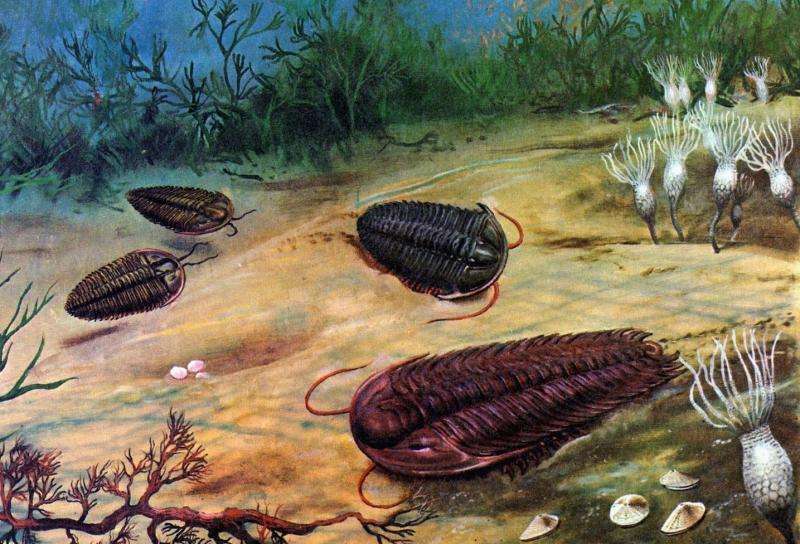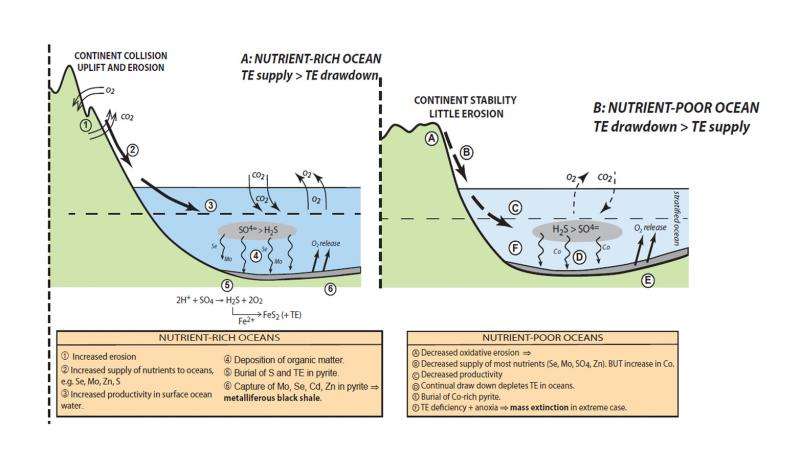Plate tectonics may have driven the evolution of life on Earth

When Charles Darwin published his theory of evolution by natural selection in 1859, the world hadn't even heard of plate tectonics. The notion that continents drifted on molten rock currents deep in the Earth's mantle was unimaginable.
So it would have come as a shock to Darwin to think the movement of the Earth's continental plates could have been a major driver of evolutionary change in all life.
In our research, published this month in Gondwana Research, we suggest that the regular collision of tectonic plates over the past 700 million years has been a prime driver of evolutionary change on Earth.
The essentials for life
We used laser technology housed in the Earth Science laboratories at the University of Tasmania to analyse more than 4,000 pyrite grains from seafloor mudstone samples collected from around the globe.
This enabled us to determine how concentrations of trace elements in the oceans have varied over the 700 million years. Trace elements included copper, zinc, phosphorus, cobalt and selenium, which are necessary for nearly all life – from marine phytoplankton through to humans – to function.
The most surprising finding was that there were certain periods in Earth's history when nutrient trace elements were highly enriched in the oceans, and other periods when levels of these critical trace elements were very low.
The nutrient-rich periods promoted rapid plankton growth in the short term, and this appears to correlate with periods of increased evolutionary change. An example of this is the rapid rise in trace elements preceding the Ediacaran (635 to 542 million years ago) and Cambrian (541 to 485 mya) periods, a time when multicellular animal life took off in a big way.
The Cambrian explosion, around 540 million years ago, is when most major groups of living animals appeared. This corresponds to a time when essential trace elements were peaking in the oceans, thus nutrient levels were very high.
The nutrient-poor periods caused depletion of plankton and promoted a slow-down in rates of diversification and ultimately could have played a role in three major mass extinction events. These occurred at the end of the Ordovician, Devonian and Triassic periods.

Although several possible explanations are given for these extinctions events, depletion in oceanic trace elements might be another plausible factor. Work is currently underway demonstrating that these events are tied to rapid declines in certain essential trace elements, particularly selenium.
Plate tectonics and nutrient cycles
Nutrients in the oceans ultimately come from weathering and erosion of rocks on thecontinents. Weathering breaks down the minerals in the rocks and releases thenutrient trace elements, which nourish life. Thus when weathering and erosion rates increase for extended periods, more nutrients are supplied to the oceans.
In the long term of geological history, erosion rates rise dramatically duringmountain building events caused by the gradual collision of tectonic plates.
Geologists have known since the 1960s that collisions of tectonic plates lead to the formation of huge mountain ranges. The Himalayas were formed when India, drifting northwards after splitting off from the supercontinent of Gondwana, slammed into Asia and pushed up the Tibetan Plateau. These collisions are called called orogenic events and their timing through Earth's history is now well established.
Continued erosion eventually depletes the surface of nutrients, causing a drop in the ocean's nutrients. This might have led to extinction events in the seas.
This is the first time nutrient trace element curves have been developed that demonstrate the relationship between tectonic collisions and the generation of cycles of nutrients.
While the link between these nutrient cycles as drivers of evolution and factors in mass extinction events remains to be proven, it really makes us think about evolution in a broad sense. Plate tectonics and evolution both operate on the same time scale of millions of years, and it seems logical that they could be causally related.
The relationship between increased nutrients in the oceans with bursts of evolutionary change are clearly correlated for the early part of the cycles, but less clear is the correlation with the evolution of advanced land animals.
Life out of the oceans
The origin of the first land animals, tetrapods about 370 million years ago, corresponds with a decrease in oceanic nutrients and a series of mass extinction events in the oceans. This could explain why certain sarcopterygian fishes with robust limbs left the seas when they did in order to leave the nutrient-poor ocean and make out on land.
But the first appearance of dinosaurs and mammals in the early Triassic, about 225 million years ago, has no correlation with trace element abundance.
Perhaps the cycles pertain mainly to biodiversity in the oceans. There is certainly a close correlation with the drop in nutrients and some global oceanic mass extinctions. These events are being tested and explored further in further research on selenium, to be released soon.
Source: The Conversation
This story is published courtesy of The Conversation (under Creative Commons-Attribution/No derivatives).
![]()




















